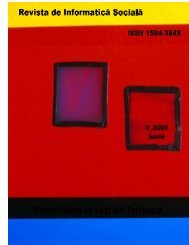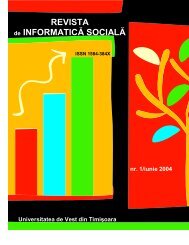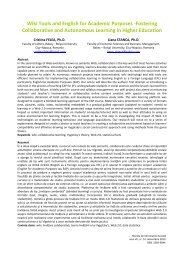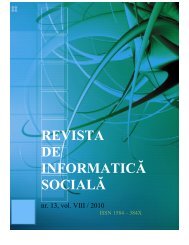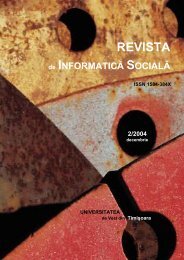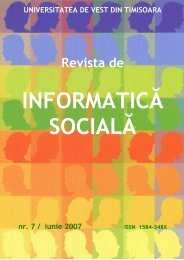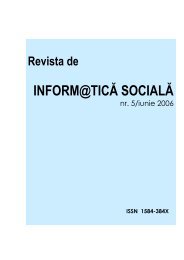web 2.0 and web 3.0 environments - Journal of Social Informatics ...
web 2.0 and web 3.0 environments - Journal of Social Informatics ...
web 2.0 and web 3.0 environments - Journal of Social Informatics ...
You also want an ePaper? Increase the reach of your titles
YUMPU automatically turns print PDFs into web optimized ePapers that Google loves.
WEB <strong>2.0</strong> AND WEB <strong>3.0</strong><br />
ENVIRONMENTS: POSSIBILITIES<br />
FOR AUTHORING AND<br />
KNOWLEDGE REPRESENTATION<br />
M A L I N K A I V A N O V A 1<br />
T A T Y A N A I V A N O V A 2<br />
Technical University S<strong>of</strong>ia<br />
College <strong>of</strong> Energetics <strong>and</strong> Electronics<br />
Blvd. Kl. Ohridski 8<br />
S<strong>of</strong>ia 1000, Bulgaria<br />
e-mail: 1 m_ivanova@tu-s<strong>of</strong>ia.bg; 2 tiv72@abv.bg<br />
Abstract<br />
Web <strong>2.0</strong> changes the authoring <strong>of</strong> eLearning<br />
content <strong>and</strong> knowledge by providing user flexible<br />
<strong>and</strong> friendly applications for developing, analyzing,<br />
publishing <strong>and</strong> sharing the instructions <strong>and</strong><br />
recourses. In the same time the authors take the<br />
benefits from participation in social networks,<br />
knowledge creation in a collaborative way, from<br />
collective intelligence. Machine processing <strong>of</strong><br />
content, programs <strong>and</strong> people relationships <strong>and</strong><br />
advanced automation <strong>of</strong> an authoring process is<br />
possible using the advantages <strong>of</strong> semantic<br />
technologies.<br />
In the paper the characteristics <strong>of</strong> social Web <strong>2.0</strong><br />
<strong>and</strong> semantic Web <strong>3.0</strong> are examined <strong>and</strong> analyzed<br />
in the context <strong>of</strong> authoring process facilitation <strong>and</strong><br />
automation. The benefits <strong>of</strong> the combination <strong>of</strong><br />
Web <strong>2.0</strong> <strong>and</strong> Web <strong>3.0</strong> authoring tools are<br />
summarized <strong>and</strong> discussed. A number <strong>of</strong> key<br />
challenges <strong>and</strong> areas for implementation which<br />
would enable more widespread adoption <strong>of</strong><br />
semantic technologies by authors are identified.<br />
Keywords: authoring, Web <strong>2.0</strong>, Semantic Web,<br />
knowledge, integration, automation<br />
7<br />
Rezumat<br />
Web <strong>2.0</strong> schimbă modalitatea de creare de site-uri<br />
şi de cunoaştere eLearning <strong>of</strong>erind aplicaţii<br />
flexibile şi uşor de folosit pentru dezvoltarea,<br />
analiza, publicarea şi partajarea informaţiilor şi<br />
resurselor. În acelaşi timp, autorii se bucură de<br />
avantajele participării în reţele sociale, în crearea de<br />
cunoaştere prin colaborare, şi de participare în<br />
inteligenţa colectivă. Procesarea conţinutului, a<br />
programelor, a relaţiilor între oameni de către<br />
maşini, precum şi automatizarea procesului de<br />
creare a unui conţinut online sunt posibile datorită<br />
tehnologiilor semantice.<br />
În această lucrare, sunt analizate caracteristicile<br />
Web <strong>2.0</strong> social şi a Web <strong>3.0</strong> semantic în contextul<br />
automatizării procesului de creare a conţinutului<br />
online. Sunt rezumate şi discutate avantajele<br />
îmbinării instrumentelor Web <strong>2.0</strong> şi Web <strong>3.0</strong> în<br />
crearea de conţinut online. Se identifică o suită de<br />
provocări şi dimensiuni care ar determina autorii de<br />
conţinut online să adopte tehnologiile semantice la<br />
scară largă.<br />
Cuvinte cheie: crearea de conţinut online, Web<br />
<strong>2.0</strong>, Web semantic, cunoaştere, integrare,<br />
automatizare<br />
Revista de Informatică <strong>Social</strong>ă<br />
vol. VII nr. 12 / Decembrie 2009<br />
ISSN 1584-384X
1. Introduction<br />
The educator in the role <strong>of</strong> an author performs series <strong>of</strong> activities such as: analyzing <strong>of</strong><br />
students’ needs <strong>and</strong> preferences, designing <strong>of</strong> instructions, content creation/editing,<br />
visualizing <strong>of</strong> data/information/knowledge, content localization, content evaluation,<br />
publishing, sharing, converting in a wide range <strong>of</strong> media formats, <strong>and</strong> reviewing to create a<br />
complete teaching/learning environment. In the Web <strong>2.0</strong> ages the author is involved in<br />
collaboration <strong>and</strong> dialog with other educators, experts <strong>and</strong> students which lead to: extension<br />
<strong>of</strong> personal network, origination <strong>of</strong> new creative ideas, transfer <strong>of</strong> knowledge or skills,<br />
elimination <strong>of</strong> intellectual isolation <strong>and</strong> widely content spreading. The created content covers<br />
well known themes as well as very specialized topics distributed to all course members or to<br />
an individual student. The development <strong>and</strong> sharing <strong>of</strong> a large number <strong>of</strong> unique content items<br />
inside <strong>and</strong> outside the mainstream education curriculum <strong>and</strong> the opportunity <strong>of</strong> an author to<br />
communicate with other authors, who share similar interests somewhere in the world, position<br />
her/him in the long tail <strong>of</strong> the content authoring. The unique product can be created utilizing<br />
the concepts, technologies <strong>and</strong> applications, characteristic <strong>of</strong> Web <strong>2.0</strong> <strong>and</strong> Web <strong>3.0</strong>.<br />
Web <strong>2.0</strong> social computing s<strong>of</strong>tware <strong>and</strong> services change the authoring <strong>of</strong> eLearning content<br />
<strong>and</strong> knowledge by providing user friendly tools for developing, finding, <strong>and</strong> remixing the<br />
relevant content <strong>and</strong> services. User (educator or learner) can choose, vote, favorite,<br />
recommend or generate learning content in collaboration with other users. The main drawback<br />
<strong>of</strong> emerging collaborative Web <strong>2.0</strong> technologies is missing or very little underlying semantic.<br />
No synonymy, meronymy or homonymy is recognized when tagging, systems usually<br />
perform syntactic (keyword based) search, <strong>and</strong> there are very few tools for explicit<br />
representation <strong>of</strong> textual or multimedia resource semantic. As a result, eLearning systems<br />
propose excellent recourses <strong>and</strong> learning strategies, organize collaboration <strong>and</strong> people<br />
collective intelligence, but they really only show <strong>and</strong> don’t process recourse content.<br />
The technologies <strong>of</strong> the Semantic Web have been quietly maturing <strong>and</strong> spreading, <strong>and</strong> now<br />
they provide formal semantics for the infrastructure <strong>and</strong> pages <strong>of</strong> the <strong>web</strong>. Both the Web <strong>2.0</strong><br />
<strong>and</strong> the technologies <strong>of</strong> the Semantic Web address the fundamental concept <strong>of</strong> socially shared<br />
meaning.<br />
In the paper the features <strong>of</strong> social Web <strong>2.0</strong> <strong>and</strong> semantic Web <strong>3.0</strong> are examined <strong>and</strong> analyzed<br />
in the context <strong>of</strong> authoring process facilitation <strong>and</strong> automation. The benefits <strong>of</strong> combination <strong>of</strong><br />
Web <strong>2.0</strong> <strong>and</strong> Web <strong>3.0</strong> authoring tools are summarized <strong>and</strong> discussed. A number <strong>of</strong> key<br />
challenges <strong>and</strong> areas for implementation which would enable more widespread adoption <strong>of</strong><br />
semantic technologies by authors are identified.<br />
2. The characteristics <strong>of</strong> Web <strong>2.0</strong> facilitating authoring<br />
The Web <strong>2.0</strong> proposes a flexible environment for authors where they can be creative <strong>and</strong><br />
innovative persons, participating in social networks, creating <strong>and</strong> spreading knowledge in a<br />
collaborative way, taking advantages <strong>of</strong> others’ wisdom [1], [2]. This new way in production,<br />
sharing <strong>and</strong> transferring the information <strong>and</strong> knowledge is a result <strong>of</strong> the new generation <strong>web</strong><br />
development. The Web <strong>2.0</strong> characteristics influences in large scale on an authoring process<br />
<strong>and</strong> it is explained below:<br />
8
- The Web <strong>2.0</strong> characterizes with new methods for data, information <strong>and</strong> knowledge<br />
gathering <strong>and</strong> remixing. Author supports his/her work using not only search engines,<br />
but he/she utilizes the indirectly collecting <strong>of</strong> information <strong>and</strong> knowledge from users’<br />
behavior. Web <strong>2.0</strong> enables access to a wide massive <strong>of</strong> data, such as pictures,<br />
bookmarks, mapping data, but also indexed data, such as the Google search index.<br />
This content can be exploited <strong>of</strong> course authors in various ways: for example, for<br />
virtual library preparing or for demo section organization. Also, authors can use the<br />
data as building blocks for creating new units <strong>of</strong> learning through remixing the<br />
existing content (according to the creative common licensing). It is now easier to build<br />
tools that exploit the data to enrich <strong>and</strong> automate the authoring.<br />
- The possibility for social networking <strong>and</strong> participating in the community <strong>of</strong> practices<br />
via Internet or mobile devices is a way for experts reaching <strong>and</strong> ideas clearing. This<br />
characteristic is called Network effect <strong>and</strong> it is used to describe the increase in value to<br />
the existing users <strong>of</strong> a service in which there is some form <strong>of</strong> interaction with others,<br />
as more <strong>and</strong> more users start to use it [3], [4]. One kind <strong>of</strong> social networks are<br />
organized around collections <strong>of</strong> content, where the user’s pr<strong>of</strong>ile remains an important<br />
way <strong>of</strong> organizing connections, but plays a secondary role to the posting <strong>of</strong> content.<br />
Video sharing site YouTube is an example <strong>of</strong> this type <strong>of</strong> service, one in which<br />
channels <strong>and</strong> comments are based around videos. Other social networking sites such<br />
as Facebook, Ning, MySpace, Twitter <strong>and</strong> Meemo allow the creation <strong>of</strong> groups <strong>and</strong><br />
pr<strong>of</strong>essional networks <strong>of</strong> educators with common interests. The sites like<br />
Academia.edu, getideas.org <strong>and</strong> Eduspaces.net are especially designed to connect<br />
educators <strong>and</strong> researchers.<br />
- The collective intelligence emerges from the participation <strong>and</strong> collaboration <strong>of</strong> many<br />
educators over the world [5]. Collective intelligence can be explicit, in the form <strong>of</strong><br />
knowledge gathered <strong>and</strong> recorded by many people <strong>and</strong> implicit intelligence that result<br />
from the data generated by the activities <strong>of</strong> many users over time. The educators form<br />
communities with common interests where they exchange ideas, units <strong>of</strong> learning <strong>and</strong><br />
learning resources, store <strong>and</strong> share them. Also, they utilize synchronous <strong>and</strong><br />
asynchronous communication modules to discuss several authoring problems.<br />
- Long tail is observing in content authoring. The primarily developed long tail<br />
framework is in the context <strong>of</strong> <strong>web</strong>-based businesses; nowadays it has its influences<br />
on the producers <strong>of</strong> content. The term “long tail” describes how our culture <strong>and</strong><br />
economy is increasingly shifting away from a focus on a relatively small number <strong>of</strong><br />
products <strong>and</strong> markets at the head <strong>of</strong> the dem<strong>and</strong> curve toward a huge number <strong>of</strong> niches<br />
in the tail [6]. For authoring, the long tail has an effect similar to that <strong>of</strong> creation <strong>and</strong><br />
construction <strong>of</strong> content, but also making content public. This allows producing,<br />
publishing, receiving <strong>and</strong> giving feedback. The long tail effect influences the content<br />
personalization in eLearning.<br />
- The <strong>web</strong> proposes working with open st<strong>and</strong>ards, using open source s<strong>of</strong>tware, open<br />
courseware, making use <strong>of</strong> free data, reusing data <strong>and</strong> working for creating innovative<br />
approaches. These open solutions can be reached using Web <strong>2.0</strong> services that allow<br />
access <strong>and</strong> dissemination <strong>of</strong> data through devices such as mobile phones, PDAs, etc.<br />
By <strong>of</strong>fering multiple sources <strong>of</strong> input, authors have access to many best practices <strong>and</strong><br />
open courses <strong>and</strong> can design interactive media resources to create a multichannel<br />
teaching/learning environment.<br />
9
2.1. Knowledge in Web <strong>2.0</strong><br />
Knowledge is understood as putting a purpose to the information in order to achieve a specific<br />
goal within concrete context. The knowledge managed in Web <strong>2.0</strong> is based on content<br />
contributed by the users. This knowledge is published, enriched, shared, communicated <strong>and</strong><br />
combined. According to Nonaka <strong>and</strong> Takeuchi a success <strong>of</strong> knowledge management (KM)<br />
within an organization is related, on the one h<strong>and</strong>, to the conversion <strong>of</strong> internalized tacit<br />
knowledge into explicit codified knowledge in order to be shared, but also on the other h<strong>and</strong><br />
for individuals <strong>and</strong> groups to internalize <strong>and</strong> make the codified knowledge personally<br />
meaningful [7]. The main focus they made is on knowledge creation <strong>and</strong> capturing which<br />
occurs during explicit <strong>and</strong> tacit knowledge conversion <strong>and</strong> takes four stages in SECI<br />
(<strong>Social</strong>ization, Externalization, Combination, <strong>and</strong> Internalization) spiral. In the era <strong>of</strong> Web <strong>2.0</strong><br />
technologies, a paradigm shift is observed in the underst<strong>and</strong>ing <strong>of</strong> information <strong>and</strong> knowledge<br />
not just as a result <strong>of</strong> a particular distribution or retrieval process, using <strong>and</strong> applying existing<br />
knowledge to new problems, but also as a result <strong>of</strong> communication, collaboration <strong>and</strong> social<br />
interactions taking place in virtual <strong>environments</strong> [8].<br />
Web <strong>2.0</strong> brings a whole new set <strong>of</strong> tools to support the generation, documentation, <strong>and</strong><br />
distribution <strong>of</strong> knowledge [9], [10]. There is an opportunity information <strong>and</strong> knowledge to be<br />
captured from many sources, including social media such as blogs <strong>and</strong> wikis, podcast<br />
programmes, <strong>web</strong>casts, <strong>web</strong>inars, social bookmarking system, social networks. In the same<br />
time, there is a challenge related to building a flexible, mashable Web <strong>2.0</strong> based environment<br />
with tools <strong>and</strong> channels for sharing <strong>and</strong> reusing <strong>of</strong> knowledge, for collaboration,<br />
communication, learning, innovation, occurring in the processes <strong>of</strong> socialization,<br />
externalization, combination <strong>and</strong> internalization.<br />
2.2. Knowledge Management Life Cycle<br />
Web <strong>2.0</strong> technologies can be used for building <strong>and</strong> exploiting information <strong>and</strong> for converting<br />
it into knowledge; they can be harnessed to support the main KM processes. There are several<br />
definitions about KM life cycle. A summary <strong>of</strong> these is proposed here, describing the key KM<br />
processes [11], [12], [13].<br />
- Knowledge creation/editing, remixing: This process is related to the creativity <strong>of</strong> an<br />
individual to develop novel <strong>and</strong> useful ideas, solutions, products, <strong>and</strong> new skills using<br />
personal or collaborative tools.<br />
- Knowledge capturing: It refers to individual ability for usage <strong>of</strong> electronic databases,<br />
open coursewares <strong>and</strong> social s<strong>of</strong>tware to gather different kind <strong>of</strong> information <strong>and</strong><br />
knowledge, in form <strong>of</strong> text, graphic, audio/ video/podcast, text/video chat sessions.<br />
- Knowledge storage/retrieval leads to the retention/accessibility <strong>of</strong> knowledge assets<br />
like written documentation, structured information stored in electronic databases,<br />
codified human knowledge in expert systems, documented organizational procedures<br />
<strong>and</strong> processes via <strong>web</strong>.<br />
- Categorising, tagging, searching <strong>and</strong> rating knowledge assets: the present social<br />
s<strong>of</strong>tware posses’ rich functions for knowledge manipulation, structuring <strong>and</strong> rating.<br />
- Knowledge transfer: it describes the availability <strong>of</strong> knowledge to be spread to<br />
locations where it is needed <strong>and</strong> used.<br />
10
2.3. Web <strong>2.0</strong> tools for knowledge management<br />
The process socialization in the SECI spiral focuses on converting new knowledge through<br />
shared experiences using the process <strong>of</strong> interactions, observing, discussing, <strong>and</strong> spending time<br />
together in same environment. During the socialization process Web <strong>2.0</strong> technologies such as<br />
social networks, communities, groups, <strong>web</strong>inars <strong>and</strong> <strong>web</strong>casts, could be appropriated for<br />
collecting learning experiences. Externalization is a quintessential knowledge creation process<br />
in that tacit knowledge becomes explicit, taking the shapes <strong>of</strong> metaphors, analogies, concepts,<br />
hypothesis, or models. During the externalization process articulated artifacts could be<br />
produced through a range <strong>of</strong> Web <strong>2.0</strong> tool, such as synchronous <strong>and</strong> asynchronous<br />
communication tools, blogs, microblogs wikis, podcasts, start pages, Zoho documents,<br />
widgets. The combination process allows reconfiguration <strong>of</strong> existing information through<br />
sorting, adding, combining, <strong>and</strong> categorizing <strong>of</strong> explicit knowledge <strong>and</strong> thus creating new<br />
knowledge. During the combination process, these articulated artifacts could be connected<br />
<strong>and</strong> combined in prototypes via technologies like mashups, RSS syndication, search engines,<br />
social bookmarking etc. By internalization the explicit knowledge becomes part <strong>of</strong> the<br />
individual’s knowledge base <strong>and</strong> <strong>of</strong> her/his underst<strong>and</strong>ing. Here again, Web <strong>2.0</strong> technologies<br />
could support individuals by <strong>of</strong>fering them simulations, games, virtual laboratories, on to<br />
stimulate them to reflect <strong>and</strong> increase their underst<strong>and</strong>ing <strong>of</strong> the issues involved.<br />
The knowledge conversions in Web <strong>2.0</strong> environment <strong>and</strong> tools for knowledge management<br />
suitable for given learning activity are presented via SECI model in Figure 1.<br />
Figure 1. SECI model for knowledge creation in Web <strong>2.0</strong> environment<br />
As the model illustrated in Figure 1 suggests, a wide range <strong>of</strong> Web <strong>2.0</strong> tools are suitable for<br />
knowledge creation, sharing <strong>and</strong> dissemination. There are two approaches for using Web <strong>2.0</strong><br />
11
tools: as st<strong>and</strong>-alone tools or as tools integrated in wider applications. For our Web <strong>2.0</strong><br />
environment prototype the second approach is chosen, combining tools <strong>and</strong> services from the<br />
following applications:<br />
- eLearning <strong>2.0</strong> system: The eLearning <strong>2.0</strong> system (LMS <strong>2.0</strong>) Edu <strong>2.0</strong>, is used, because<br />
<strong>of</strong> its huge mashup functions for knowledge transfer through possibilities for: RSS<br />
syndication, link <strong>and</strong> code embedded, widgets’ integration. Also, it allows flexible<br />
management <strong>of</strong> collaborative strategies, sharing knowledge <strong>and</strong> best practices via<br />
wiki, course <strong>and</strong> private blogs, community <strong>and</strong> groups.<br />
- Mashup authoring Web <strong>2.0</strong> applications: Glogster is used for interactive educational<br />
posters creation; visual authoring studio Sprout Builder for rich-media content <strong>and</strong><br />
widgets building.<br />
- Web <strong>2.0</strong> Applications for code generation <strong>and</strong> sharing: SlideShare <strong>of</strong>fers a possibility<br />
for documents (.doc, .ppt, .pdf) storage <strong>and</strong> converting in embed code or link; social<br />
publishing site Scribd for documents sharing; YouTube <strong>and</strong> Vimeo for video upload<br />
<strong>and</strong> embeding.<br />
- Mashup editor Dapper for quickly creating <strong>of</strong> widgets, RSS feeds, image loops.<br />
- <strong>Social</strong> Networks such as Classroom <strong>2.0</strong>, Ning in Education, The Global Education<br />
Collaborative <strong>and</strong> ect. are involved places for knowledge capturing <strong>and</strong> sharing,<br />
communication, <strong>and</strong> knowledge collaboration to discuss practice experience <strong>and</strong><br />
theory concepts.<br />
3. Semantic Web for Content Producers<br />
Semantic technologies represent <strong>and</strong> manage knowledge at the level <strong>of</strong> concepts across<br />
documents, models, s<strong>of</strong>tware systems, <strong>and</strong> infrastructure. The Semantic Web provides a<br />
common framework for <strong>web</strong>–based knowledge representation, sharing <strong>and</strong> reusing across<br />
application, enterprise, <strong>and</strong> community boundaries.<br />
3.1. Knowledge representation in the Semantic Web<br />
Semantic Web technologies enable people to create data stores on the Web, build<br />
vocabularies, <strong>and</strong> write rules for h<strong>and</strong>ling knowledge. The main knowledge representation<br />
formalism is ontology. It represents the concepts, properties, hierarchical <strong>and</strong> non hierarchical<br />
relations between concepts <strong>and</strong> individuals in machine-processable way. More formally, the<br />
ontology is a duple i = , where Ci, is the set <strong>of</strong> concepts to conceptualize a<br />
domain, Ti is the set <strong>of</strong> taxonomic relations, Ri is the set <strong>of</strong> non-taxonomic relations, Ii is the<br />
set <strong>of</strong> individuals <strong>and</strong> Ai is the set <strong>of</strong> axioms specifying additional rules <strong>and</strong> restrictions. The<br />
ontologies propose a reach model for domain knowledge representation <strong>and</strong> reasoning.<br />
Ontology languages for Web ontologies are RDFS, DAML + OIL <strong>and</strong> OWL. OWL [14] is a<br />
semantic markup language for publishing <strong>and</strong> sharing ontologies on the Web. OWL is<br />
developed as a vocabulary extension <strong>of</strong> RDF (the Resource Description Framework) <strong>and</strong> is<br />
derived from the DAML+OIL Web Ontology Language. OWL language provides three<br />
sublanguages: OWL Lite, OWL DL <strong>and</strong> OWL Full. OWL Lite was designed for easy<br />
implementation, effective reasoning <strong>and</strong> to provide users with a functional subset that will get<br />
them started in the use <strong>of</strong> OWL. OWL DL (where DL st<strong>and</strong>s for "Description Logic") was<br />
designed to support Description Logic reasoning <strong>and</strong> to provide a language subset that has<br />
12
desirable computational properties <strong>and</strong> in the same time desidability. The complete OWL<br />
language (called OWL Full) contains all the OWL language constructs <strong>and</strong> provides free,<br />
unconstrained use <strong>of</strong> RDFS constructs. It proposes a maximal expressive power, but without<br />
any guarantee for decidability. OWL’s layered architecture <strong>and</strong> underlined logical ground<br />
make him a st<strong>and</strong>ard for Web ontology representation. There are several highly optimized<br />
description logic reasoning engines for checking OWL ontology consistency <strong>and</strong> inferring<br />
new knowledge (Table 1).<br />
3.2. Ontology engineering tools <strong>and</strong> methodologies<br />
Ontology is a complicated knowledge representation object. There are several ontology types<br />
according to their purpose or knowledge granularity: core ontologies, domain ontologies, tack<br />
ontologies, global ontologies, <strong>and</strong> application ontologies. There are a lot <strong>of</strong> freely available<br />
<strong>web</strong> ontologies in nearly every type or domain, but usually knowledge is rapidly changing or<br />
subjective <strong>and</strong> granularity is tack-dependent. That is why everyone (from knowledge expert to<br />
domain expert or usual user) may need to develop, modify or enrich ontology.<br />
As a result <strong>of</strong> difficulty <strong>and</strong> task-dependence <strong>of</strong> ontology engineering process, there are a lot<br />
<strong>of</strong> methodologies for various tasks, type <strong>of</strong> building ontology, resources, <strong>and</strong> pr<strong>of</strong>iciency level<br />
<strong>of</strong> ontology creators. There are methodologies for building ontology from scratch, for<br />
extending, enrichment or population. Depending from human involvement there are manual,<br />
semiautomatic <strong>and</strong> automatic approaches (the last are known as ontology learning).<br />
Depending from used resources there are methods for ontology building from text, from other<br />
ontologies, from <strong>web</strong> resources, manually from experts or using many different type<br />
resources. When other ontologies are used, the ontology mapping or alignment tools, methods<br />
or approaches are needed.<br />
It has been developed a gr<strong>and</strong> variety <strong>of</strong> tools for ontology engineering in recent years.<br />
Semantic Web ontology engineering tools were initially designed before the rise <strong>of</strong> the Web<br />
<strong>2.0</strong> methods for managing large-scale socially contributed content <strong>and</strong> most <strong>of</strong> them are for<br />
individual usage from knowledge or domain experts. With the growth <strong>of</strong> Web <strong>2.0</strong> it began to<br />
develop a new generation <strong>of</strong> semantic tools, unifying principles <strong>of</strong> Web <strong>2.0</strong> <strong>and</strong> Web <strong>3.0</strong>,<br />
called <strong>Social</strong> Semantic Web Tools. Bellow we analyze <strong>and</strong> classify ontology engineering<br />
tools in context <strong>of</strong> their possible usage for Web <strong>2.0</strong> enrichment <strong>of</strong> technologies for knowledge<br />
management.<br />
3.3. Classification <strong>of</strong> Semantic Web ontology engineering tools<br />
A lot <strong>of</strong> Semantic Web or ontology engineering tools have been developed during the last<br />
years. We will analyze <strong>and</strong> classify the most important <strong>of</strong> them. There are several main types<br />
<strong>of</strong> tools according to their purpose (Table 1): Ontology API, Ontology editors, Semantic Web<br />
servers, Visualization tools, Reasoning engines, ontology development <strong>environments</strong>,<br />
Annotation tools, Ontology alignment tools, Ontology learning tools, repositories.<br />
- Ontology API is set <strong>of</strong> classes for programmatically manipulating ontology<br />
information (for example adding or removing classes, properties, relations,<br />
individuals). The Alignment API is an API <strong>and</strong> implementation for expressing <strong>and</strong><br />
sharing ontology alignments.<br />
13
- Ontology editors are applications designed to assist knowledge engineers or domain<br />
experts in the creation or manipulation <strong>of</strong> ontologies. They <strong>of</strong>ten express ontologies in<br />
one <strong>of</strong> many ontology languages, propose graphical design environment <strong>and</strong> interfaces<br />
for implementing reasoners. Some <strong>of</strong> them provide export to many ontology<br />
languages.<br />
- An ontology server is used at design, commit <strong>and</strong> runtime. At design time, the<br />
ontologist uses the server for developing ontologies. At commit-time, players (i.e.<br />
human or applications) commit to a limited part <strong>of</strong> the ontology to enable the<br />
exchange <strong>of</strong> messages. At runtime, players exchange messages mediated by shared<br />
ontologies.<br />
- Visualization <strong>of</strong> ontologies is difficult because ontology is more than a hierarchy <strong>of</strong><br />
concepts. It is enriched with role relations between concepts, concepts have various<br />
attributes related to them <strong>and</strong> concepts probably have instances attached to them.<br />
Therefore, it is not simple to create a visualization that will display effectively all this<br />
information <strong>and</strong> will at the same time allow the user to perform easily various<br />
operations on the ontology. Some 2D <strong>and</strong> 3D useful visualization tools are shown in<br />
Table 1.<br />
Table 1. Classification <strong>of</strong> ontology engineering tools<br />
Type Approach/subtype Tool<br />
Ontology API<br />
OWL API, Jena, Protégé-OWL API, SOFA<br />
API for ontology alignment<br />
Ontology editors<br />
Protégé, Semantic Studio, Be Informed Suite, COE,<br />
HOZO, OBO-Edit,<br />
RDF k42, Joseki, rdftp, RAP NetAPI , AllegroGraph<br />
Semantic Web servers Ontology Ontolingua, KSL, ACOS , Starlab, OntoRama,<br />
OWS<br />
2D OntoRama, TGVizTab, OZONE,<br />
Visualization tools 3D IsaViz, 3D Hyperbolic Tree, Cone Tree,<br />
OntoSphere<br />
Browsers (extensions)<br />
GrOWL, OwlSight, SWOOP, myWeb, Semantic<br />
Turkey<br />
OWL - DL Euler, OWLJessKB, FaCT++, Pellet, RacerPro,<br />
Reasoning engines<br />
SHER<br />
OWL-Full, F-logic KAON2, Jena, Bossam, surnia<br />
Ontology development<br />
OntoStudio, CMap COE, NeOn Toolkit, DOME,<br />
<strong>environments</strong><br />
TopBraid Composer, OntoEdit<br />
Semantic Annotation<br />
Adobe's XMP Amilcare, KIM, Annotea, GATE,<br />
tools<br />
MnM<br />
Ontology mapping <strong>and</strong> Manual Snoogle, Optima, CogZ<br />
alignment tools Automatic X-SOM, COMA++<br />
From text<br />
Ontology learning tools<br />
From <strong>web</strong><br />
ASIUM, OntoLT, KAON, Text-2-Onto, Mo’K<br />
Text-To-Onto, OntoLearn,<br />
- The ontology browser allows <strong>web</strong> users to navigate around ontologies in the same familiar<br />
environment, but produces the pages dynamically <strong>and</strong> is available for direct use with a <strong>web</strong><br />
14
- A semantic reasoner is a tool, able to infer logical consequences from a set <strong>of</strong> asserted<br />
facts or axioms, or check ontology consistency. Many reasoners use first-order predicate<br />
logic to perform reasoning or some his subsystems as Description logic (DL). Inference<br />
commonly proceeds by forward chaining <strong>and</strong> backward chaining. There are also examples<br />
<strong>of</strong> probabilistic reasoners, for example Pronto - probabilistic description logic reasoner.<br />
Reasoners are usually built in ontology editors or ontology development <strong>environments</strong>.<br />
- Semantic Annotation tools analyze natural language texts <strong>and</strong> recognize references to<br />
entities (like persons, organizations, locations, dates). Then it tries to match the reference<br />
with a known entity, having a unique URI <strong>and</strong> description in the knowledge base.<br />
- Ontology learning <strong>and</strong> ontology alignment tools are tools, primarily used for automatic or<br />
semiautomatic ontology engineering. Ontology Alignment, or ontology matching, is the<br />
process <strong>of</strong> determining correspondences between elements <strong>of</strong> two or more ontologies. The<br />
goal <strong>of</strong> ontology learning is to (semi-)automatically extract relevant concepts <strong>and</strong> relations<br />
from a given corpus, other ontologies, Web or other kinds <strong>of</strong> data sets to form ontology.<br />
These tools <strong>and</strong> technologies are very exciting, but are far from his maturity.<br />
Semantic Web knowledge engineering tools propose logically reach technologies for<br />
knowledge management, but most <strong>of</strong> them are very sophisticated <strong>and</strong> difficult to use for<br />
domain experts or usual users <strong>and</strong> don’t support or stimulate collaborative knowledge<br />
engineering.<br />
4. How Semantic Web technologies can improve Web <strong>2.0</strong><br />
As Semantic Wave Report 2008 [16] says, the Semantic Web is about representing meanings,<br />
connecting knowledge, <strong>and</strong> putting these to work in ways that make our experience <strong>of</strong> internet<br />
more relevant, useful, <strong>and</strong> enjoyable. The Web <strong>3.0</strong> solution is to give the Internet a knowledge<br />
space <strong>and</strong> it is the third <strong>of</strong> the four stages <strong>of</strong> Internet growth, shown on Figure 2.<br />
Figure 2. What is the evolution <strong>of</strong> the Internet to 2020?<br />
Source: Nova Spivak, Radar Networks: John Breslin, DERI; & Mills Davis, Project 10x<br />
Web <strong>3.0</strong> cover a broad range <strong>of</strong> knowledge representation <strong>and</strong> reasoning capabilities<br />
including pattern detection, deep linguistics, ontology <strong>and</strong> model based inference, analogy<br />
<strong>and</strong> reasoning with uncertainties, conflicts, causality <strong>and</strong> values. The Figure 3 depicts forms<br />
15
<strong>of</strong> knowledge representation that can span tag collections (or folksonomies) to dictionaries,<br />
taxonomies <strong>and</strong> thesauri, schemas <strong>and</strong> conceptual models, to ontologies or axiologies (valuebased<br />
reasoning). Reasoning requires knowledge representation. More powerful forms <strong>of</strong><br />
representation will be chosen to enable more powerful kinds <strong>of</strong> reasoning <strong>and</strong> problem<br />
solving.<br />
Figure 3. From Searching to Knowing – Spectrum for Knowledge Representation <strong>and</strong><br />
Reasoning Capabilities.<br />
Source: Dr. Leo Obrst, Mitre; Mills Davis, Project10x<br />
The integration <strong>of</strong> social Web <strong>and</strong> semantic technologies in Web <strong>3.0</strong> lowers the cost <strong>of</strong> data<br />
<strong>and</strong> knowledge creation by using volunteers <strong>and</strong> collective human intelligence. Web <strong>3.0</strong><br />
systems try to connect data, services <strong>and</strong> applications by integrating knowledge about these<br />
applications, content sources, <strong>and</strong> process flows. This integration must be done dynamically,<br />
in real time using automated <strong>and</strong> semi-automated methods.<br />
The shared meanings <strong>and</strong> knowledge in Web <strong>3.0</strong> have to be generated from educators (not<br />
only from knowledge or domain experts but also from usual users) <strong>and</strong> computers (knowledge<br />
acquisition from text <strong>and</strong> other <strong>web</strong> resources, semantic annotations). When knowledge is<br />
encoded in a semantic form, it becomes transparent <strong>and</strong> accessible at any time to a variety <strong>of</strong><br />
reasoning engines. New sources <strong>of</strong> information will be integrated by modeling knowledge,<br />
adding intelligence, <strong>and</strong> enabling learning <strong>and</strong> reasoning.<br />
Web <strong>3.0</strong> will take social computing [17] to the level <strong>of</strong> Semantic <strong>Social</strong> Computing which<br />
will develop <strong>and</strong> exploit knowledge in all forms, e.g.: content, models, services, & s<strong>of</strong>tware<br />
behaviors. Personal <strong>and</strong> social computing powered by semantic technologies will add<br />
underlying knowledge representations to data, tags, processes, services, <strong>and</strong> s<strong>of</strong>tware<br />
functionality. The wisdom <strong>of</strong> crowds will come not from the consensus decision <strong>of</strong> the group,<br />
but from the semantic <strong>and</strong> logical aggregation <strong>of</strong> the ideas, thoughts, <strong>and</strong> decisions <strong>of</strong> each<br />
individual in the group.<br />
Integration <strong>of</strong> Semantic Web <strong>and</strong> Web <strong>2.0</strong> will bring a Semantic email, Semantic blogging,<br />
Semantic tagging, Semantic bookmarking, Semantic social networking, Semantic wikis <strong>and</strong><br />
Semantic usites.<br />
16
- Semantic email provides pr<strong>of</strong>iles, threads, topics, contents, <strong>and</strong> addresses that both<br />
humans <strong>and</strong> machines can interpret <strong>and</strong> take action on. The objective is to make emails<br />
both human <strong>and</strong> machine underst<strong>and</strong>able in order to simplify many common email<br />
related tasks, e.g.: collecting information from a group <strong>of</strong> people; organizing email by<br />
message content, topics, <strong>and</strong> task as well as by sender <strong>and</strong> receiver pr<strong>of</strong>iles; automating<br />
follow-ups <strong>and</strong> updates. Semantic searching will access email by concepts, relationships,<br />
<strong>and</strong> context<br />
- Semantic blogging propose enhancement <strong>of</strong> personal <strong>web</strong> journal with machine<br />
interpretable semantic annotations <strong>and</strong> personal or domain ontologies. Semantic blogs<br />
add semantic metadata to posts. These annotations associate concepts, relationships <strong>and</strong><br />
other structured information to the content, e.g., contact details <strong>of</strong> a person, bibliographic<br />
data etc. Semantic blog capabilities include: semantic view (adjusting blog presentation<br />
in a semantically appropriate manner); semantic navigation; semantic query.<br />
- Semantic tagging ads to folksonomy semantic relationships, mapped between tags, users,<br />
<strong>and</strong> site resources. It maps relationships between tags, enables tag meta-searching to look<br />
for similar patterns <strong>of</strong> tagging between users <strong>and</strong> tag clouds, <strong>and</strong> allows sharing <strong>and</strong><br />
faceted navigation across community content. Semantic tagging can use some freely<br />
available Web ontologies as FOAF (Friend <strong>of</strong> a Friend) which concepts can describe<br />
human or machine agents, which generate tags, as well as relationships among users;<br />
SKOS (Simple Knowledge Organization Systems);Topic Maps, which concepts can<br />
provide a semantically rich way to specify the concept <strong>of</strong> a tag <strong>and</strong> the relationships<br />
among tags in a given social space; SIOC (Semantically Interlinked Online Community)<br />
which concepts can describe site information, relationships among site-resources, <strong>and</strong><br />
site-site relationships.<br />
- Semantic bookmarking associate links to <strong>web</strong> resources with externally represented<br />
concepts in a domain ontology.<br />
- Semantic social networking extends the concept <strong>of</strong> social computing <strong>and</strong> content<br />
syndication with explicit semantic descriptions <strong>of</strong> people, sites, <strong>and</strong> content <strong>and</strong> new<br />
functionality such as: Personal pr<strong>of</strong>ile generator, Blog content reader, semantic search or<br />
aggregation tool, Authoring tool that publishes blog posts plus a content syndication<br />
(RSS) file that also (automatically) includes references to the author's personal pr<strong>of</strong>ile<br />
(FOAF) <strong>and</strong> the FOAFs <strong>of</strong> any cited authors.<br />
- Semantic usites is a collaborative <strong>web</strong>site with predominantly user generated content<br />
linked to a machine-interpretable knowledge model. The knowledge is used to organize<br />
<strong>and</strong> interrelate content in the site <strong>and</strong> facilitate access to, navigation <strong>of</strong>, <strong>and</strong> dynamic<br />
reporting <strong>of</strong> information.<br />
- Semantic wikis are a relatively new field <strong>of</strong> research for improving navigation <strong>and</strong> search<br />
in the wiki. The main aim <strong>of</strong> semantic wikis is to make acquisition, maintenance, <strong>and</strong><br />
mining <strong>of</strong> knowledge simpler, faster, <strong>and</strong> more flexible. Regular wikis have structured<br />
text <strong>and</strong> untyped hyperlinks. Semantic wikis extend the concept <strong>of</strong> a wiki to include an<br />
underlying model <strong>of</strong> the knowledge described in its pages. This knowledge model is<br />
expressed in a formal language, so that machines can process it. The idea is to enrich wiki<br />
environment with formal knowledge representation <strong>and</strong> management. Semantic wikis<br />
capture <strong>and</strong> identify further information about topic pages <strong>and</strong> their relations (i.e.,<br />
semantic metadata), using semantic annotations, thesauruses or ontologies <strong>and</strong> on this<br />
basis improve search <strong>and</strong> knowledge integration.<br />
17
5. eLearning <strong>and</strong> <strong>Social</strong> Semantic Web Knowledge<br />
Management Tools <strong>and</strong> Approaches<br />
There are two main approaches for integrating Web <strong>2.0</strong> <strong>and</strong> Web <strong>3.0</strong> technologies: implicit<br />
<strong>and</strong> explicit. The main characteristic <strong>of</strong> implicit approach is the background usage <strong>of</strong> semantic<br />
<strong>and</strong> intelligent technologies whereas in explicit approaches Web <strong>2.0</strong> sites or portals propose<br />
semantic <strong>web</strong> tools, adapted for the usual user.<br />
5.1. Implicit approaches<br />
Implicit approaches are very useful for facilitating <strong>and</strong> automating learning content creation<br />
or usage. In [18] an approach for dynamically generating personalized hypertext relations<br />
powered by reasoning mechanisms over distributed RDF annotations is proposed. Several<br />
ontologies have been used: a domain ontology (describing the document space, the relations<br />
<strong>of</strong> documents, <strong>and</strong> concepts covered in the domain <strong>of</strong> this document space), a user ontology<br />
(describing learner characteristics), <strong>and</strong> an observation ontology (modeling different possible<br />
interactions <strong>of</strong> a user with the hypertext). For generating hypertext structures, presentation<br />
ontology has been introduced. As a result the approach generates a personalized conceptual<br />
context <strong>of</strong> learning resources which may be used for automatic learning resources selection.<br />
A Wiki is a medium for collaboration that allows many people to participate in the production<br />
<strong>of</strong> a long-term knowledge repository. It is excellent tool for collaborative learning in Web<br />
environment. St<strong>and</strong>ard Wiki’s drawback is his knowledge organization only on syntactic<br />
level. Semantic wikis combine the philosophy <strong>of</strong> wikis with the concepts <strong>and</strong> techniques <strong>of</strong><br />
the Semantic Web (i.e. enriching the data on the Web with well-defined meaning). Two main<br />
types <strong>of</strong> semantic wikis can be distinguished: text-centered (that enrich classical wiki<br />
<strong>environments</strong> with semantic annotations) <strong>and</strong> logic-centered (that use semantic wikis as a<br />
form <strong>of</strong> online ontology editors). Semantic MediaWiki [19], IkeWiki[19], SweetWiki [21],<br />
<strong>and</strong> HyperDEWiki [22] are examples <strong>of</strong> text-centered semantic wikis, whereas OntoWiki [23]<br />
<strong>and</strong> myOntology [24] are examples <strong>of</strong> logic-centered semantic wikis. In SweetWiki an OWL<br />
schema captures concepts such as wiki word, wiki page, forward <strong>and</strong> backward link, author,<br />
etc. This ontology is then used by an embedded semantic search engine (Corese). SweetWiki<br />
integrates a st<strong>and</strong>ard WYSIWYG editor (Kupu), extended to support semantic annotation<br />
based on "social tagging" Freebase, Knoodl [25], SWIRRL, <strong>and</strong> Twine [26] are <strong>web</strong><br />
applications that do not call themselves “semantic wikis" but exhibit many <strong>of</strong> their<br />
characteristic properties are some examples.<br />
5.2. Collaborative Web <strong>2.0</strong> based ontology building approaches<br />
<strong>and</strong> lightweight tools<br />
Ontologies are very important not only for searching <strong>and</strong> automatic information integration,<br />
but they are useful tool for knowledge underst<strong>and</strong>ing in the learning process. That is why we<br />
should consider them as important type <strong>of</strong> learning resource. As it is shown above, most <strong>of</strong><br />
the current methodologies <strong>and</strong> tools for building ontologies are intended for specialized<br />
knowledge engineers. The latest emerging approach in ontology building is to develop<br />
methodologies <strong>and</strong> tools for lightweight Web <strong>2.0</strong> based collaborative ontology construction or<br />
maturing.<br />
18
A lot <strong>of</strong> current research <strong>and</strong> development concentrates more on what we can do as soon as<br />
we have ontologies rather than having a closer look at the processes <strong>of</strong> creating <strong>and</strong> especially<br />
maintaining such (domain-specific) ontologies. Ontology maturing approach [27] views<br />
ontology building as a maturing process that requires collaborative editing support <strong>and</strong> the<br />
integration into the daily work processes <strong>of</strong> knowledge workers. It is rather for ontology<br />
refinement or maturing rather than building from scratch. This approach is implemented in a<br />
lightweight ontology editor SOBOLEO <strong>and</strong> <strong>web</strong> annotation tool, integrated into the browser.<br />
SOBOLEO is based on AJAX technology (using the Google Web Toolkit) It uses lightweight<br />
easy to use graphical interface <strong>and</strong> can be easily invoked from other applications; e.g. here in<br />
combination with social bookmarking<br />
RapidOWL methodology [28] is proposed to support adaptive, semantic collaboration<br />
between knowledge engineers <strong>and</strong> domain experts (<strong>and</strong> possibly users). This methodology is<br />
based on the idea <strong>of</strong> iterative refinement, annotation <strong>and</strong> structuring <strong>of</strong> a knowledge base. It is<br />
light-weight, easy-to-implement, <strong>and</strong> support distributed <strong>and</strong> highly collaborative scenarios.<br />
The proposed joint Ontology Design <strong>and</strong> Community Modeling promote communication<br />
between educators <strong>and</strong> thus help by spreading <strong>and</strong> reusing the knowledge. Ontology<br />
Evolution enables to undo problematic changes or slightly modify ontologies before usage in<br />
similar contexts.<br />
[29] Introduces community-driven ontology management as a new approach to ontology<br />
construction. A framework allowing <strong>and</strong> motivating collaborative ontology construction <strong>and</strong><br />
reuse for the end users has been developed <strong>and</strong> applied in semantically-enhanced community<br />
portals for ontology construction with the involvement <strong>of</strong> real users.<br />
[27] Presents the ontology maturing processes, which is based on the insight that ontology<br />
engineering is a collaborative informal learning process <strong>and</strong> for which we analyze<br />
characteristic evolution steps <strong>and</strong> triggers that have users engage in ontology engineering<br />
within their everyday work processes. This model integrates tagging <strong>and</strong> folksonomies with<br />
formal ontologies <strong>and</strong> shows maturing pathways between them. As implementations <strong>of</strong> this<br />
model, lightweight collaborative image-based ontology engineering tool <strong>and</strong> ontologyenabled<br />
social bookmarking (SOBOLEO) tool are proposed.<br />
Web-Protege [30] is an open source, lightweight, <strong>web</strong>-based ontology editor. It supports the<br />
process <strong>of</strong> collaborative ontology development in a <strong>web</strong> environment. Web-Protege uses the<br />
Google Web Toolkit (GWT) for the user interface, Protege for supporting ontology<br />
services(including DIG reasoning engines interface), <strong>and</strong> components <strong>of</strong> Collaborative<br />
Protégé [31] to augment the ontology-editing environment with facilities for discussions <strong>and</strong><br />
annotations. It is both powerful <strong>and</strong> easy to use <strong>and</strong> can be used from teachers or students<br />
collaboratively.<br />
6. Conclusion<br />
Web <strong>2.0</strong> technologies propose lightweight easy to use technologies for building <strong>and</strong><br />
exploiting information <strong>and</strong> converting it into knowledge by means <strong>of</strong> collective human<br />
intelligence. They have proven in practice their workability <strong>and</strong> effectiveness as a means <strong>of</strong><br />
<strong>of</strong>fering an opportunity for sharing <strong>and</strong> collective processing <strong>of</strong> the knowledge <strong>of</strong> many<br />
educators/authors. Their drawbacks are the lack <strong>of</strong> strict logical ground for inferring new<br />
knowledge, for proving the quality <strong>of</strong> human-generated knowledge as well as technologies for<br />
automatic knowledge extraction, management <strong>and</strong> integration.<br />
19
Semantic Web <strong>of</strong>fers complicated well-developed logic based technologies for knowledge<br />
processing in a Web environment, but technologies for automatic knowledge extraction <strong>and</strong><br />
integration are not mature, most <strong>of</strong> all tools are hard to use for domain experts or users <strong>and</strong><br />
don’t support collaborative knowledge management.<br />
Our main conclusion is that integration <strong>of</strong> Web <strong>2.0</strong> application design patterns <strong>and</strong> Semantic<br />
Web logics <strong>and</strong> knowledge management should give rise to a new <strong>and</strong> exciting environment -<br />
the <strong>Social</strong> Semantic Web. In a <strong>Social</strong> Semantic Web, certain, formally representable parts <strong>of</strong><br />
human knowledge can be encoded <strong>and</strong> reasoned about via the tools <strong>of</strong> the Semantic Web <strong>and</strong><br />
it can also easily be maintained via the social, community-oriented techniques <strong>of</strong> Web <strong>2.0</strong>.<br />
Semantic technologies will guarantee the efficient search (via semantic search approaches) <strong>of</strong><br />
learning resources, information or services, automatic knowledge management, accuracy<br />
consistency <strong>and</strong> integration, while Web <strong>2.0</strong> will guarantee the collaborative human<br />
participation.<br />
References<br />
[1] Higher Education in a Web <strong>2.0</strong> World. (2009). Report <strong>of</strong> an independent Committee <strong>of</strong><br />
Inquiry into the impact on higher education <strong>of</strong> students’ widespread use <strong>of</strong> Web <strong>2.0</strong><br />
technologies. http://www.jisc.ac.uk/media/documents/publications/he<strong>web</strong>20rptv1.pdf.<br />
[2] Franklin, T. & van Harmelen, M. (2007). Web <strong>2.0</strong> for Content for Learning <strong>and</strong> Teaching<br />
in Higher Education.<br />
http://www.jisc.ac.uk/media/documents/programmes/digitalrepositories/<strong>web</strong>2-contentlearning-<strong>and</strong>-teaching.pdf.<br />
[3] Katona, Z, Zubcsek, P.P. & Sarvary, M. (2009). Network Effects <strong>and</strong> Personal Influences:<br />
Diffusion <strong>of</strong> an Online <strong>Social</strong> Network. http://www.cs.bme.hu/~zskatona/pdf/diff.pdf.<br />
[4] Hendler, J. & Golbeck, J. (2007). Metcalfe's Law, Web <strong>2.0</strong>, <strong>and</strong> the Semantic Web.<br />
http://www.cs.umd.edu/~golbeck/downloads/Web20-SW-JWS-<strong>web</strong>Version.pdf.<br />
[5] The Horizon Report 2008 Edition. (2008). The New Media Consortium <strong>and</strong> the<br />
EDUCAUSE Learning Initiative. http://www.nmc.org/pdf/2008-Horizon-Report.pdf.<br />
[6] Anderson, C. The Long Tail. http://www.changethis.com/pdf/10.01.LongTail.pdf.<br />
[7] Nonaka, T.H. (1995). The Knowledge-Creating Company. New York: Oxford University.<br />
[8] Chatti, A., Klamma, R., Jarke, M. & Naeve, A. (2007). The Web <strong>2.0</strong> Driven SECI Model<br />
Based Learning Process. Proceedings <strong>of</strong> the international conference on Advanced Learning<br />
Technologies ICALT-2007.<br />
[9] Alex<strong>and</strong>er, B. (2006). Web <strong>2.0</strong>: A New Wave <strong>of</strong> Innovation for Teaching <strong>and</strong> Learning?.<br />
Educause Review. 41(2). http://www.educause.edu/ir/library/pdf/erm0621.pdf.<br />
[10] The Future <strong>of</strong> Higher Education: How technology will shape learning. (2008). A report<br />
from the Economist Intelligence Unit, Sponsored by the New Media Consortium.<br />
http://www.nmc.org/pdf/Future-<strong>of</strong>-Higher-Ed-%28NMC%29.pdf.<br />
[11] Alavi, M. & Leidner, E. (2001). Review: Knowledge management <strong>and</strong> knowledge<br />
management systems: conceptual foundations <strong>and</strong> research issues. MIS Quarterly 25/1. pp.<br />
107-136.<br />
[12] Davenport, T. H. & Prusak, L. (1998). Working Knowledge: How organizations manage<br />
what they know. Harvard Business School Press. Boston.<br />
20
[13] Liebowitz, J. (2000). Building Organizational Intelligence: A Knowledge Management<br />
Primer. Boca Raton. FL: CRC Press.<br />
[14] OWL Web Ontology Language Reference. W3C Recommendation. 10 February 2004.<br />
http://www.w3.org/TR/owl-ref/.<br />
[15] Katifori, A. & Halatsis, C. (2007). Ontology Visualization Methods – A Survey.<br />
http://portal.acm.org/citation.cfm?id=1287621.<br />
[16] Davis, M. (2008). Semantic Wave 2008 Report: Industry Roadmap to Web <strong>3.0</strong><br />
&Multibillion Dollar Market Opportunities. Executive Summary.<br />
http://www.isoco.org/pdf/Semantic_Wave_2008-Executive_summary.pdf.<br />
[17] Davis, M. et al. (2007). Semantic <strong>Social</strong> Computing.<br />
http://colab.cim3.net/file/work/SICoP/2007-09-20/MDavis09202007.pdf.<br />
[18] Henze, N.et al. (2004). Reasoning <strong>and</strong> Ontologies for Personalized E-Learning in the<br />
Semantic Web.<br />
[19] http://semantic-mediawiki.org/wiki/Semantic_MediaWiki.<br />
[20] http://semantic<strong>web</strong>.org/wiki/IkeWiki.<br />
[21] http://semantic<strong>web</strong>.org/wiki/SweetWiki.<br />
[22] Schwabe, D. & Rezende da Silva, M. (2008). Unifying Semantic Wikis <strong>and</strong> Semantic<br />
Web Applications. 7th International Semantic Web Conference (ISWC2008), volume 401.<br />
CEUR Workshop Proceedings.<br />
[23] http://demo.ontowiki.net/.<br />
[24] Siorpaes, K. & Hepp, M. (2007). MyOntology: The Marriage <strong>of</strong> Ontology Engineering<br />
<strong>and</strong> Collective Intelligence. http://www.heppnetz.de/files/SiorpaesHepp-myOntologyeswc07-camready.pdf.<br />
[25] http://knoodl.com/ui/home.html.<br />
[26] http://www.twine.com/.<br />
[27] Braun, S. (2007). Ontology Maturing: a Collaborative Web <strong>2.0</strong> Approach to Ontology<br />
Engineering. http://www2007.org/workshops/paper_14.pdf.<br />
[28] Auer, S., et al. (2007). RapidOWL - an Agile Knowledge Engineering Methodology.<br />
http://www.informatik.uni-leipzig.de/~auer/publication/RapidOWL.pdf.<br />
[29] Zhdanova, A. V. (2008). Community-driven ontology construction in social networking<br />
Web Intelligence <strong>and</strong> Agent Systems. An International <strong>Journal</strong> 6, 1–29 portals.<br />
http://userver.ftw.at/~zhdanova/papers/community_journal.pdf.<br />
[30] Tudorache, T. et al. (2008). Web-Protege: A Lightweight OWL Ontology Editor for the<br />
Web. http://www.<strong>web</strong>ont.org/owled/2008/papers/owled2008eu_submission_40.pdf.<br />
[31] Tudorache, T. et al. (2008). Supporting Collaborative Ontology Development in Protégé,<br />
http://bmir.stanford.edu/file_asset/index.php/1374/BMIR-2008-1331.pdf.<br />
21



